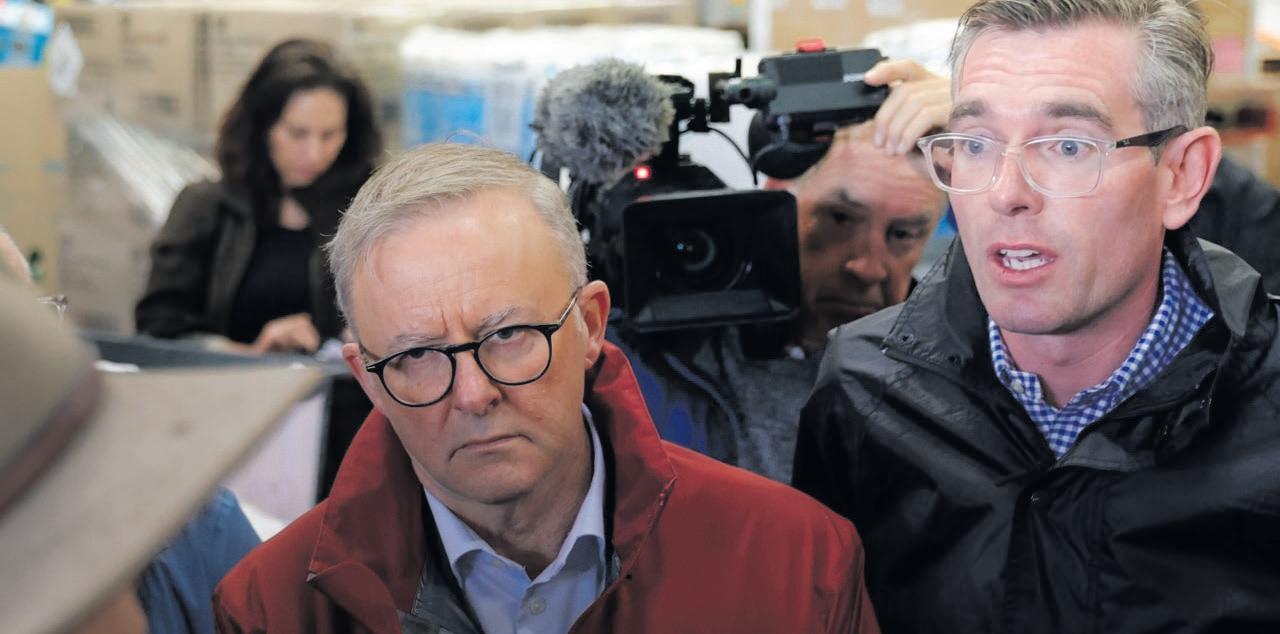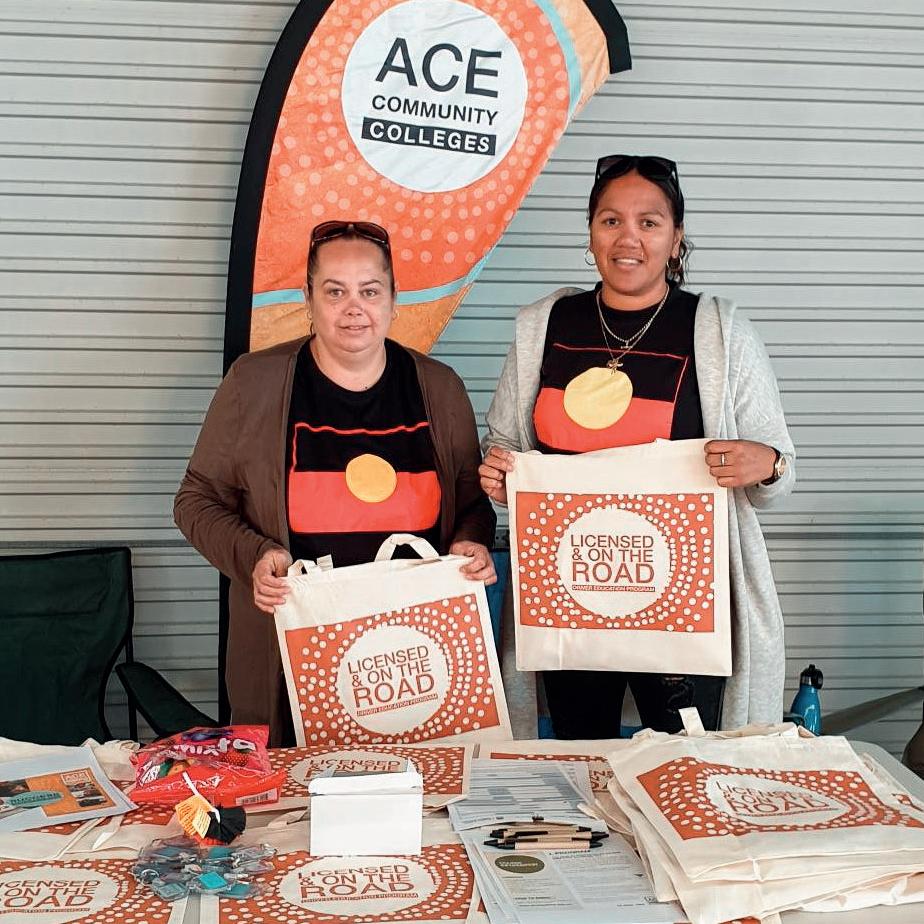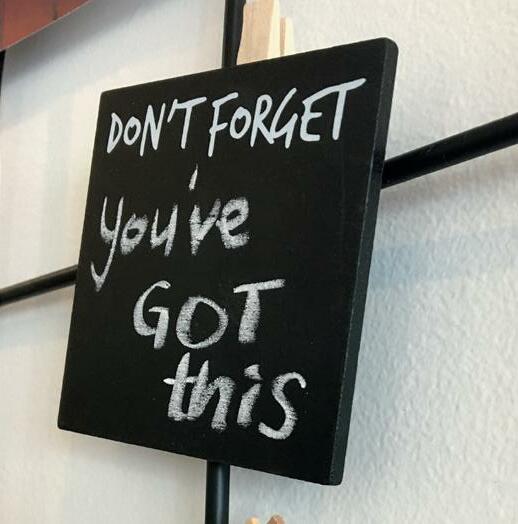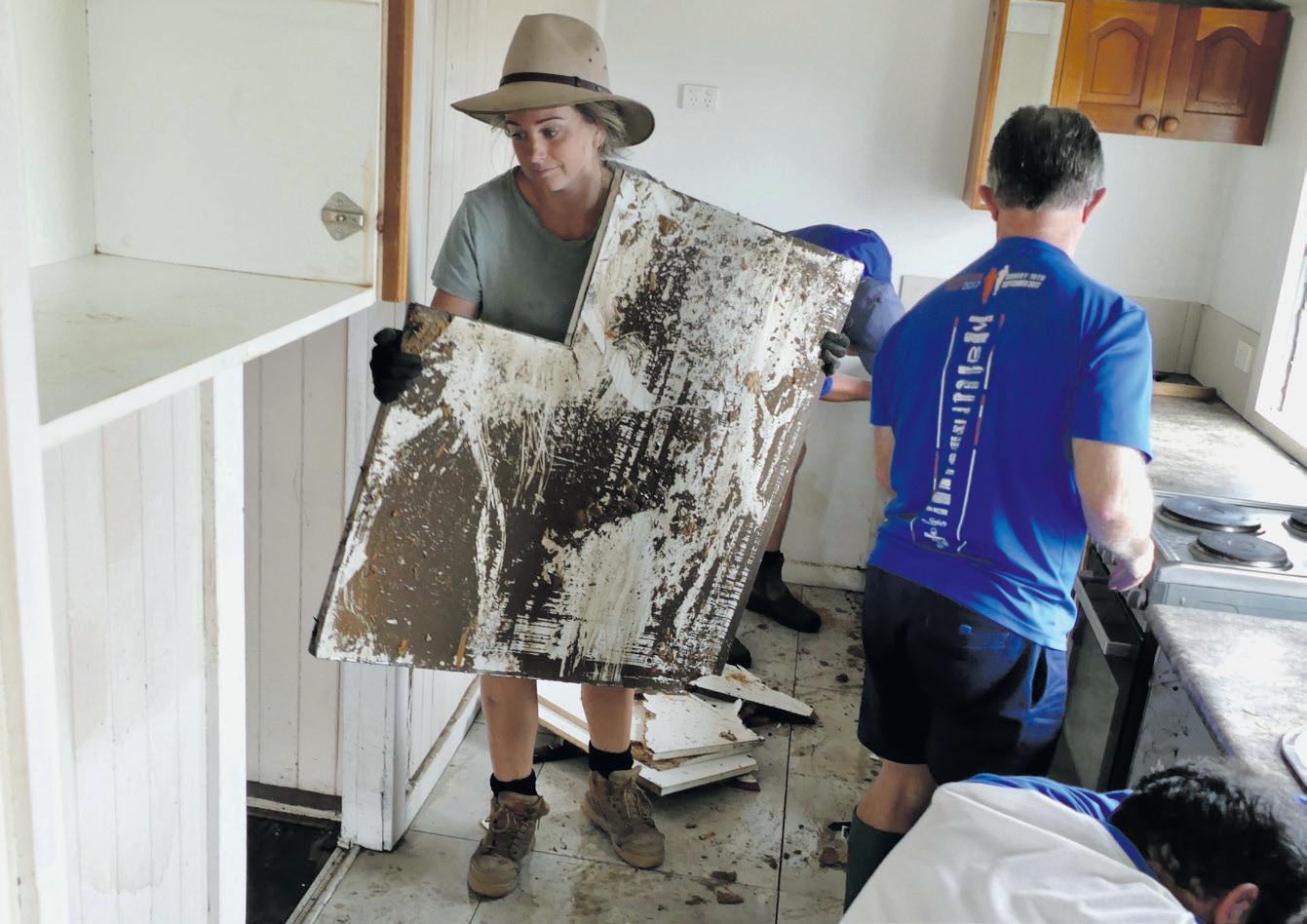
27 minute read
also welcomed Friday’s announcement of the Northern Rivers Voluntary Home Buy Back scheme. “It’s been the work of the Northern Rivers Reconstruction Corporation over the last few months that’s got through the nuts and bolts of what’s needed. I’m glad to see the full extent of the program now,” he said. Mayor Lyon expected those ‘worst affected’ will benefit first from the scheme with further funding “closer to $1 billion in total” and likely skilled-worker stimulus packages still to come. He said wait-times for trades in the Byron Shire, are already blown out to “the end of next year, at the earliest,” Mayor Lyon said. “We know that when we’re talking about buying back homes to
Most resilience funding should head north says MP
By TIM HOWARD
The Clarence Valley is unlikely to be a major recipient of an $800 million government package to help flood affected people on the Northern Rivers recover from flood damage to their homes.
Member for Clarence Chris Gulaptis, whose electorate takes in Lismore as well as the Clarence Valley, said the bulk of funds in the Resilient Homes Program, which provides funding for government to buy back homes, raise homes and repair homes would be triaged to the most flood affected regions.
But he said it might be some time before work was done in the Clarence, due to the number of trades people who were working out of the area and shortages of some building materials.
Last week the Prime Minister, Anthony Albanese, was in Lismore to announce the program.
He reveal about 2000 home owners in in the Lismore, Ballina, Byron, Tweed, Kyogle, Richmond Valley and Clarence Valley shires will be eligible for the scheme.
He said home owners with properties directly damaged either by floodwater or subsequent landslips would be considered.
Eligibility was be based on expert property assessments, flood impact severity data, safety risks and potential future flood level.
Mr Albanese said the scheme was expected to be funded and delivered in phases over the next five years, with $700 million shared equally between the state and federal governments.
The remaining $100 million was for the state government’s land acquisition program, which would involve buying land in floodsafe locations for future development.
The program offers three options for home owners: buybacks, house-raising and retrofitting homes.
Mr Gulaptis agreed with the prime minister that the bulk of the money, $520 million, would go towards voluntary buybacks for people living in the most vulnerable areas where major flooding would pose a catastrophic risk to life.
He said with the possibility of a few exceptions around the Lower Clarence, this would be around the Lismore area, where the most catastrophic flooding occurred.
The Northern Rivers Reconstruction Corporation said home owners would receive a payment for the purchase of their house and land.
The exact location of these areas were yet to be revealed, with buyback zones expected to be discussed at community meetings to be held from Friday.
Corporation chief executive David Witherden said people would be free to take their payout money and move to wherever they chose.
Mr Gulaptis said Clarence residents would be more likely to take advantage of $100,000 funding for house raising or $50,000 for retrofitting homes to make them flood resistant.
Eligible residents would be able to apply for up to $100,000 each to raise their homes by elevating liveable areas to a property-specific flood level.
Mr Witherden said the funding would be for homes in areas where there was less flood risk.
He said the location and the design of the house would come into play, depending on how easy it would be to elevate.
Mr Witherden said the option of retrofitting was for houses in areas less susceptible to severe flooding.
“We start with those most at risk with the potential for a buyback, then as the risk reduces the opportunities are there for house raising,” he said.
People seeking to access the program should go to https:// www.nsw.gov.au/ regional-nsw/northernrivers-reconstructioncorporation/ resilient-homes-fund/ resilient-homes-program to find more details.
Further information will be available at public information sessions, to be held across all seven Northern Rivers local government areas from Friday.
Volunteers help strip the interior of a food damaged house near Ulmarra in the aftermath of the February/March foods.

By JANELLE SAFFIN MP STATE MEMBER FOR LISMORE
EIGHT months on from the catastrophic flood of February 28 2022, I have written to NSW Premier Dominic Perrottet to take stock of where the Northern Rivers region, and in particular the Electorate of Lismore that I represent, stands in regard to our flood recovery. I welcomed the Premier’s joint announcement made with Prime Minister Anthony Albanese last week on an $800-million Resilient Homes Fund package for the Northern Rivers that I strongly advocated for since early days.
I have let the community know that it is a start, not the end, and will take considerable time.
It is importantly the first in New South Wales as we embark on the transformational adaptation that is required to live with wild weather and climate change.
The form to express your interest in the Resilient Homes Fund can be found at https:// www.nsw.gov.au/.../ res.../resilient-homesprogram...
Now that this package is being put in place, it is imperative that a comprehensive EconomicEnvironmental Recovery Plan be rolled out for the Northern Rivers.
I am thankful for the range of flood recovery assistance grants that are available to impacted residents and businesses, some of which we have never had like the one for commercial and residential landlords and the Resilient Homes Fund.
An EconomicEnvironment Recovery Plan needs to be shaped through the lens of what has happened here; that is we were hit by an event that was akin to an inland tsunami, leaving in its wake a humanitarian disaster on a scale not seen since Darwin’s Cyclone Tracy in 1974.
We need economic and environmental plans for all seven local councils and Tenterfield Shire (Lismore Electorate) reviewed with detailed consideration given to transformational adaptation.
In Australia, there has been adaptation but to date it has been incremental which is why an EconomicEnvironmental Recovery Plan becomes more imperative with our rebuild, and in some instances, our staged retreat, which cannot simply mean abandonment.
The Northern Rivers Reconstruction Corporation (NRRC) is doing some good work in this space. They are building capacity and have a good leader in Chief Executive David Witherdin yet they need to be let off the leash, so to speak.
The advent of the Resilient Homes Fund
will facilitate this somewhat. I say let the NRRC get on with the job it is designed to do rather than needing Ministerial approval before they sneeze.
The NRRC’s Advisory Board needs to be chaired by a local person of standing rather than an Acting Secretary of the
Department of Regional NSW, otherwise it is a bureaucratic board, not our board.
The Advisory Board should also be out and about having community conversations. The NRRC I know does do this too, as they are meeting so many people but they also need space to work.
It’s quite bizarre that none of the Advisory Board’s members permanently resides in Lismore, the epicentre of February’s disaster, or in Murwillumbah, Woodburn, etc., that also got smashed.
I acknowledge that tens of millions have gone towards the rollout of temporary housing or pod villages – also a first for NSW – but it’s a process I described in Parliament as clunky, slow and not done in collaboration with community, and lacking any creativity whatsoever.
I have had representations and conversations with Mayors, Councillors and others who say the pod village idea needs a complete rethink. It needs to be done in close collaboration with all community leaders, notably Councils.
I know land is problematic but it requires more than here is Crown Land, here is Council land aka sporting fields and that is where the pods go. Also some of the places where people are now housed require better care.
I shall continue to advocate to secure the changes and developments we need.

Prime Minister Anthony Albanese and our local politicians listening to Brian Burgin’s story
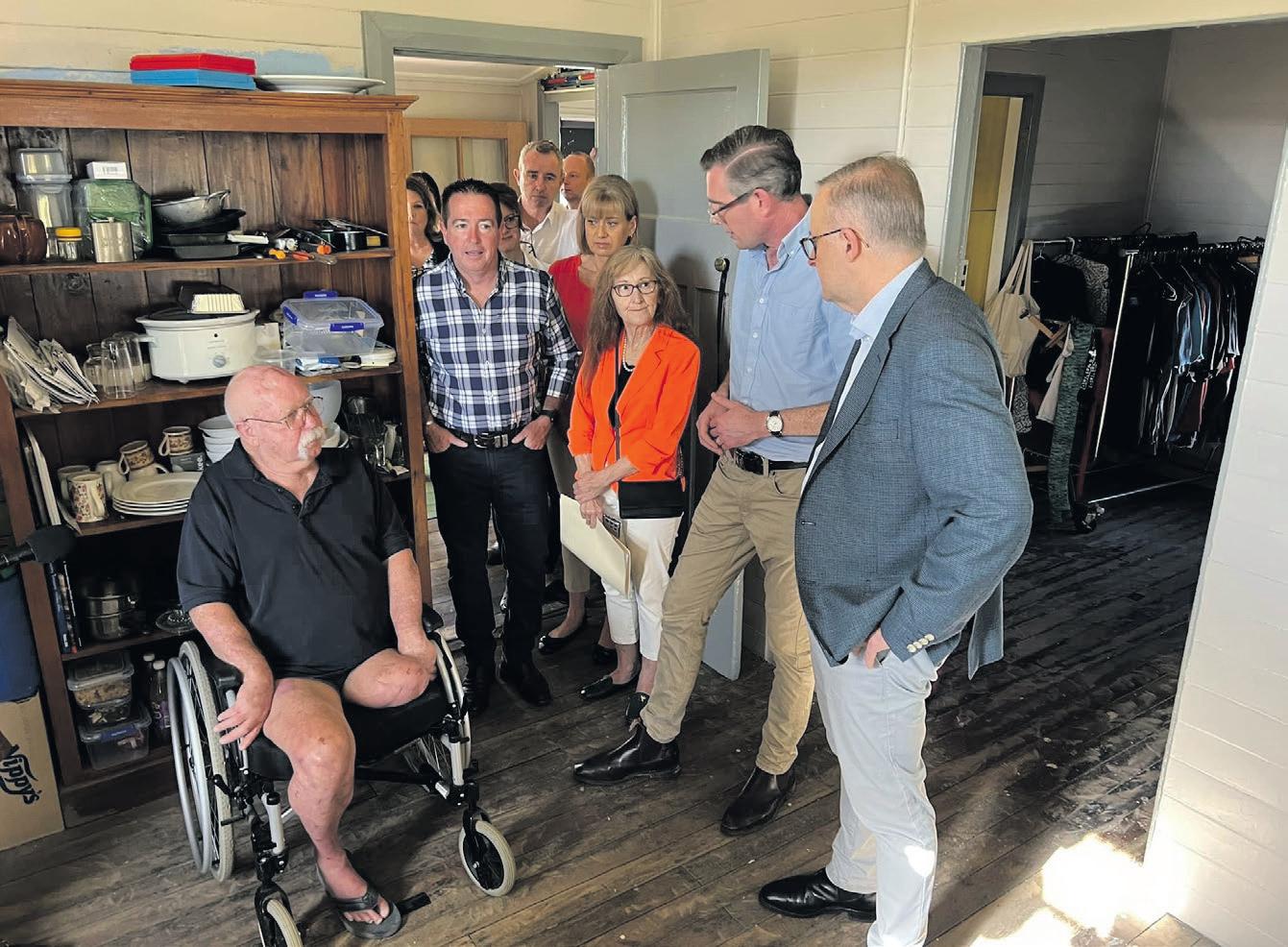
Brian Burgin’s home

Beekeeping Supplies More than you imagine
Visit your local Book Warehouse store today!
TENTERFIELD

120 Grand Years of ShowGoing in Murwillumbah

120-years of the Murwillumbah Show
By MARGARET DEKKER
After a 2-year break brought by Covid-19 restrictions, the grand old Murwillumbah Show is fnally back, and in time to celebrate its remarkable 120-year milestone.
“The Murwillumbah Show is proud to be one of the longest continuously running Agricultural Shows in Australia and remains a key event in the annual calendar of the Tweed. Since the frst Show in 1898, the Murwillumbah Show has celebrated the best of local agriculture and produce and offered an annual event where the town meets the country,” Murwillumbah Show organisers proudly state.
The 2-day show, which opens this Friday, November 4 at 5pm, has everything a classic country show could offer from the Sideshow Alley to the Halls Family Rodeo in Centre Ring where some of Australia’s ‘fnest cowboys take on the bucking bulls!’ Live music, bars and a wide variety of food vendors will make it a great day and night out for families and locals.
Saturday is the ‘business-end’ of the show, starting early with Showjumpers and their horses walking the course from 7am with day-long equestrian events to follow including the Grand Parade and Queen Elizabeth II Supreme Exhibit of the Show. An extensive cattle judging program of Beef and Dairy, as well as championship Dog, Poultry and Miniature Goat events also fll
Saturday’s program.
From 9am on Saturday, Main and Johnson Pavilions open to the public featuring local farm produce, jams and preserves, needlework, crafts, pottery making, woodwork and more.
There’s a Heritage Display complete with sheep shearing and cow milking demonstrations as well as Trade Displays, an interactive ‘Reptile Kingdom’ and activities for the kids including fossil digging and petting zoo.
And it will be clear you’re in Murwillumbah with a unique Cane Exhibit, with awards for the ‘Best 9 Stalks of the Show!’
From 3:30pm on Saturday, International Horseman Guy McLean will present 3 Shows in Centre Ring during the afternoon with his biggest in the evening.
“Since 1999, Guy and his amazing team have featured at many major events including Royal Shows, Equitana, International Rodeos and the Man from Snowy River Festival. Another of Guy’s talents is bush poetry, having twice been crowned Australian Bush Poet Champion,” Murwillumbah Show organisers state.
Guy’s shows will be followed by a demonstration from the Kamalori Vaulting Team.
Concurrently running in Centre Ring on Saturday afternoon will be 3 displays from Aussie FMX Freestyle Motocross.
To really fre up the 120th celebrations, a huge freworks spectacular will take place from 8:45pm on Saturday night in Centre Ring, “especially choreographed to celebrate our historic 120th Murwillumbah Show” in between events from Saturday night’s big Rodeo Night.
The popular Northern Rivers blues-rock-funk band ‘The Jacks Band’ will rock the night away with the Sideshow Alley fnally closing its gates at 11pm after seeing in yet another Murwillumbah Show .. for the 120th time.
Gate ticket prices start at $10 for child/ concession, Adults $15, Families $30 with discounts for 2-day tickets and tickets purchased online.

A mound and modest house please!
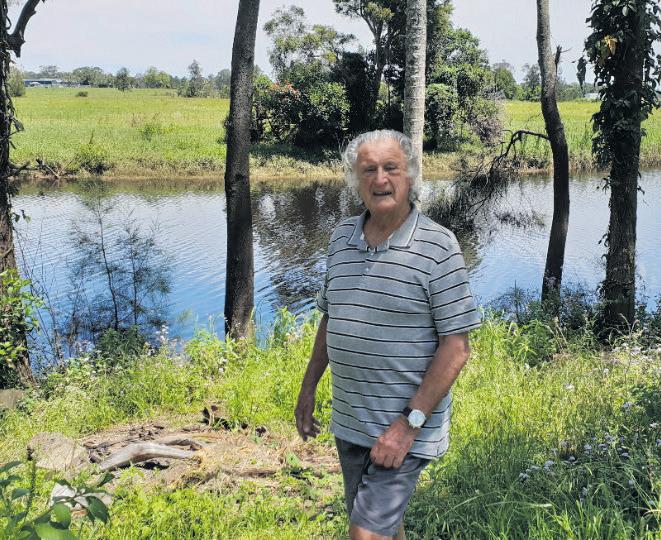
Bob May in front of Rocky Mouth Creek
By Samantha Elley
Bob May of Woodburn shows me into his single storey home, on the banks of the Rocky Mouth Creek, normally a very picturesque place. But as I walk into his home, a different tale unfolds as I look at the sarking covered walls and the very basic, cupboard-less kitchen, built to provide practical support.
“The water got to that line of nails on the gyprock,” Bob says, pointing to a place twothirds up the loungeroom wall.
“In the afternoon (of February 28) I watched the water come up the bank and come across the back lawn…the orchid houses were half underwater.
“I went to bed and it got wet and the carpet was sopping wet.
Thanks to his greatniece who phoned the SES on his behalf and the heroic efforts of neighbours Derek and Marcus who after an hour of searching, found his house in the early hours of March 1, Bob didn’t drown.
“They pulled me out of the house. Two of us had to push the door against the current to get me through to the front door where they were because the current was so strong,” Bob said.
“How they knew how to get there, I don’t know. “There were no roads, you couldn’t see anything. “They rescued 40 people that night and I was the last one.” Bob now lives in the shell of his home, having made the necessary adjustments to live reasonably comfortably. He listened with interest to last week’s announcement from the Prime Minister Anthony Albanese and NSW Premier Dominic Perrotet in regard to the Resilience Home Fund. “I have no confdence that anything will happen for me personally here at Woodburn in the short term,” he said. “I don’t know if I’m considered a high risk property. “I believe living 40 metres from the bank of Rocky Mouth Creek; I am high risk.” Bob plans to go and see Resilience NSW and ask them what the defnition of high risk means. “I am 85 and I haven’t got 30 years to wait,” he said. “I don’t wish to live in this house, subject to the possibility of another food. “I want to be confdent that should another disastrous situation like (February and) March 2022 arrive, I am on higher ground.” Bob says his preference is to build a mound on his property with a modest house on top. “I’ve got heaps of room, I’ve got eight and a half acres here,” he said. “Even if it had to be a couple of shipping
containers joined
together and somehow
furnished inside so that
I’ve got a bathroom and
kitchen.”
Bob doesn’t want to
leave Woodburn, as he
loves the community
he settled into 15 years
ago and doesn’t want a
buyback situation where
he’s worried he would
have to move another
community.
“There are very
clear indications from
government, both state
and federal that they
would like communities
to remain intact as much
as possible,” he said.
“Already people have
left Woodburn and
my concern is people
like (local businesses)
have invested probably
millions in keeping their
businesses going and if
Jacaranda Festival back to blooming best

By TIM HOWARD
Staring out the sea of faces in Grafton’s Market Square as the judges revealed the identity of the 2022 Jacaranda Ambassador and Princess had festival president Desan Padayachee breathing easier. When Jacaranda Ambassador Amanda Daffey and Jacaranda Princess Trinity Gutteridge accepted
their titles he was sure the new look Jacaranda Festival was heading in the right direction. “I was on stage with Brooke McClymont co-compering and all I could see was peoples faces stretching away from the stage,” he said. “Obviously over the past three years we haven’t been able to have anything like that, so as I looked out out at 1500 to 2000 people I just thought, Jacaranda is back.” Mr Padayachee congratulated all the people who took part in the 2022 Jacaranda Quest. “We got some really worthy winners with Amanda Daffey, and Trinity Gutteridge, as well as Junior Queen Molly Cosgrove and Junior Prince Ella Roach, but all the candidates were could be proud of their efforts,” he said. As well as the evidence of his eyes, Mr Padayachee revealed he has a secret source to assess Jacaranda attendance. “I always ask the food vendors how they’re trading,” he said. “This year they’re telling me they’re having to restock their vans mid event at most venues. “So I would say we’re on track to have a record
year this year.” But it hasn’t been plain sailing for the organisers as some anti-social behaviour during the
disrupted event planning with potentially deadly results. He said new Grafton Redmen rugby union coach Gary Powell had supplied a contingent of his new Fijian player cohort to erect the giant truss marquee in Market Square. “They had the structure up about a metre off the ground in 22 minutes and we decided to leave it and put it up to its full height later,” he said. “But during the night a bunch of little hooligan got onto it and danced all over it and on Tuesday we could see it had become damaged. “One of them had become trapped underneath it, but thankfully all the damage he suffered was a bruise to his shin. He was taken to hospital and released after treatment. “But when we looked underneath we could see some of the structure was bent and damaged and I didn’t want to take the risk of seating 600 people under it in that state.” Mr Padayachee said the organisers took it in their stride, lumping it with other Jacaranda events like the fire in the skirts of the Jacaranda Jill in 2019 and the disruption due to Covid-19. “The show has to go
on,” he said “Things like that seem a big deal at the time, but if you move on, it seems to work out. “We decided the weather was going to be fine and it turned out to be a beautiful evening.”


It’s simple everyday actions like recycling, which can contribute to a better environment, and recycling week is a great opportunity to think how we can keep improving. Now in its 27th year, National Recycling Week (Monday 7 to Sunday 13 November 2022) provides an important opportunity for councils, workplaces, schools and individuals to improve our recycling knowledge, develop better recycling habits and build greater trust in recycling. As part of the week’s activities, councils are encouraging everyone to contin-
ue their efforts to recycle right, and to think beyond our kerbside bin “ As a region, the Northern Rivers is tracking well above the state average, with a 59% recovery rate from our kerbside recycling and organics bins” said Linda Tohver, Education Coordinator of North East Waste. “It’s also becoming even easier to recycle more than just the usual paper, cardboard, glass, hard plastics, and steel and aluminium cans that belong in our yellow-lid recycling bin. “ Check it before you chuck it! The Australasian Recycling Label Program has made the process of identifying which household products can go in which bin much easier now for householders. Keep an eye out for the instruction labels on common household items (eg. meat trays and cheese containers) that shows which bin each component of the packaging can go into as well as where recycling can occur in-store. Our top tips for recycling beyond your kerbside bin: •Return and Earn – Currently accepts drink containers such as cans, beer and mixer bottles, cartons, juice boxes and poppers. In 2023 this will expand to bigger soft drink and juice bottles and wine bottles. •Household and car batteries, paints, oils, gas bottles and fuoro globes and tubes and smoke detectors are accepted for FREE when you drop them off at any of the north coast’s network of 8 Community Recycling Centres (CRCs). Find your nearest CRC at newaste. org.au/crc •Soft plastics can be recycled through a REDCYCLE approved collection supermarket; •Various take- back schemes through Terracycle.com are now in place for a variety of beauty, self-care and dental products. •For small quantities of some problem wastes, like household batteries and mobile phones, residents have access to the region’s network of FREE Community Recycling Stations, installed by north coast Councils and North East Waste. They can be found at various easy to access locations across the region including council admin offces, libraries and community centres. To fnd out more, visit newaste.org. au/crs or contact your council. •Most household batteries can also be recycled at B-cycle drop off points available at participating retailers including Woolworths, Coles, Aldi, Bunnings and Battery World.

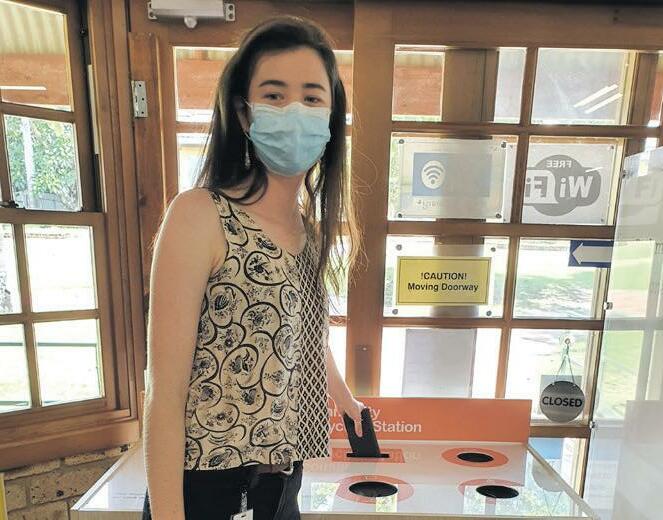
Community Recycling Centres
The right place for your problem waste
Paint Gas bottles Fluoro globes and tubes
Smoke detectors
Household batteries Car batteries Motor oils Other oils
There are Community Recycling Centres at: Ballina, Byron, Casino, Grafton, Kyogle, Lismore, Maclean & Stotts Creek, Tweed
For more information or to fi nd your nearest Community Recycling Centre contact your local council or visit www.newaste.org.au/crc
Panel approves controversial food plain DA
By TIM HOWARD
A State Government planning body has cleared the way for a 136-lot managed housing estate on the West Yamba foodplain.
At its third attempt on October 26, the Northern Region Planning Panel has approved a controversial development application to build a $34 million managed housing estate at 8 Park Ave, West Yamba.
The developers, Hometown Australia Pty Ltd’s, development application was substantially approved at the NRPP’s frst meeting in March 2022, but the panel was not satisfed with stormwater mitigation and evacuation plans for the development submitted at the second meeting in July.
The panel, which included Clarence Valley mayor Ian Tiley and his deputy, Greg Clancy, voted 3-2 in favour of approving the development. Theirs were the two votes against approval.
Speaking on local radio after the decision, Cr Tiley said he had argued against the panel decision once all the submissions had been heard.
He was most disappointed the decision downplayed the role of climate change.
“We have to far more deeply consider climate change effects,” he said.
Surprisingly it was the assessment of Clarence Valley Council staff ahead of fndings from an independent peer review that appeared to sway the panel.
The review, prepared by engineering consultancy Rhelm Pty Ltd to assess the developer’s food emergency management plan, said climate change had not been factored into the plan.
When panel chairman Paul Mitchell quizzed council development and land use planning manager Murray Lane, Mr Lane downplayed the effects of climate change and said it had been suffciently catered for in the developers FEMP.
The developers also countered a claim in the Rhelm peer review objecting to the developer food plan, which allowed residents to shelter within the site.
The developers said the peer review had infated the numbers of residents who would need to take shelter in a bowling club built above maximum food height.
It said the peer review’s estimate of more than 250 was based on an infated projection of the number of residents in Hometown developments.
It said the average was about 1.1 people per dwelling, far less than the number the Rhelm report said would overwhelm the facilities on site.
Cr Tiley was at a loss to explain how the decision had been made.
“Mr Mitchell has asked me and the deputy mayor for a written explanation of our views against approval,” Cr Tiley said.
“I presume he and the other two panel members will do the same for their views.
“Then we might get an idea of their thinking and reasoning behind their decisions.”
Cr Tiley said councils needed to fnd ways to halt development on food plains.
“The Prime Minister, Anthony Albanese, said we have to do more to mend planning regulations to halt this development,” he said.
Member for Clarence Chris Gulaptis also bought into the argument after the decision.
Mr Gulaptis has a history with the development, as it was a company bearing his name, surveying frm Gulaptis & Smith, whose environmental assessment plan in the early 2000s was used to help approve developments in West Yamba.
But 20 years later Mr Gulaptis said a lot has changed and there were better methodologies to assess the food risk.
“When we assessed food risks we would ask neighbours to indicate the height of the last food and we would add half a metre to that,” he said. “Most of the time we couldn’t be certain they had remembered correctly.
“Now there are food studies done that look at food data over time. We also understand the effects climate change will have on food heights.”
Mr Gulaptis said developments on the West Yamba foodplain should not be allowed now with the information available to consent bodies.
But Cr Tiley said councils could not go it alone, as previous councils had approved zonings which the owners of properties on food plains relied on.
“We don’t have the money to defend decisions which overruled those zonings,” he said.
Another surprise was the panel’s response to Byron Bay councillor and former civil engineer Duncan Bey.
He said the development application and the food plan did not consider all the mechanisms of food water moving through the landscape.
Chiefy he identifed lateral movement of water through the soil, which the developer had not factored in.
But when the panel quizzed the developer about this it accepted an answer from Hometown engineer, Steve Pickford, even though he initially appeared to confuse the concept with moving water underground through pipes.
Mr Mitchell said also questioned Mr Bey’s over his history as a civil engineer working for a developer at West Yamba
He asked him if he had always put his ethics ahead of the wishes of his employer.
Mr Bey replied he had included letters he wrote expressing reservations about the development in his submission to the panel.
The approval shocked a large number of Yamba residents who have been campaigning against this and other developments in West Yamba since the area was opened to developers in 1995.
Yamba Community Action Network member Lynne Cairns, who addressed the NRPP on behalf of the group, said the decision had gutted residents.
She was also critical of the way the panel allocated time to speakers.
Mrs Cairns expected to address the panel for 10 minutes, the amount of time allocated to speakers representing groups.
Instead the chair interrupted her after three minutes and reluctantly allowed her to continue after she explained her position.
Mrs Cairns presented an email which showed clearly she had been granted approval to speak on behalf of her organisation and would be allocated 10 minutes of time.
“I wish I had applied for more time, but I was so focussed on what I was saying and annoyed at the interruption, I didn’t think to do it,” she said.
She pointed out it was not the only time the panel chair displayed questioned people making submissions.
“I was shocked when the chair started questioning Mr Bey about his role historically,” Mrs Cairns said.
“When the developers engineers addressed the panel, he didn’t ask them if the development conficted with their ethical standards.”
She said the chair also dealt harshly with a submission from a resident, Andrew Taylor, when he asked him if he realised the effects on his property would not go away if they development was not approved.
She said another surprising factor was the way the panel sidestepped a late submission from the NSW National Parks, which objected to the way storm water would drain from the site into a swale on Shores Dr before eventually entering a marine reserve.
The developers argued the swale was part of the council’s responsibility and council engineers downplayed its signifcance. The substance of the National Parks objection was not revealed because National Parks did not address the panel.
Many of the the 14 people who made submissions were also concerned at the proposal to install pumps to remove water from the site and a proposal for the developer to capture and treat stormwater in a large holding tank onsite before it was released.
They said the need for pumps had not been spelled out in the original proposals and they were concerned they would fail, without backup power supplies in a food emergency.
Residents were also concerned the capacity of the holding tank on the site could not cope with amount of water storms like the February/March rain events would deliver to the site.
Mrs Cairns said while there was bitter disappointment among the residents, they were looking for avenues to continue to oppose the development
Diary of a Flood Survivor Part 15
By SAMANTHA
ELLEY
Well didn’t the announcement from the Prime Minister and NSW Premier get a lot of tongues wagging in my little community?
An option to retrofit, raise or have our houses bought back, but only if we are seen as a being threatened by another flood.
I’ll give you the drum, anyone living near a river who went through the trauma of February and March’s floods are threatened with future events.
Just ask any flood survivor who watched the most recent flood warnings, how many hours sleep they got that night.
Hubby and I had a deep initial five minute discussion about possible options.
Raising our house is out of the question as it is already raised and short of making it a skyscraper, that option didn’t stop a metre of water going into the second floor.
Retro-fitting the house is also a bit late. We have a newer house and when we built it, we put the powerpoints up high and did whatever flood requirements were necessary 13 years ago.
That leaves a possible buy-back. And the rumour is the government will buy our houses at pre-flood prices.
The problem here is, if the government were to buy our house back, where do we go?
As one neighbour said, we love our community.
While the businesses have poured their hard earned money into reestablishing themselves, what happens if all the residents get bought out and move to Upper Come-Back-to-West?
The trouble is many of us have fallen in love with the river lifestyle.
When it is behaving, it is a beautiful piece of nature that we can boat and fish on, we can picnic by and take stunning photos at dawn or sunset.
The offer from the government is an extremely generous one and no doubt, many will take up the offers of raising, retro-fitting or selling their homes to move. We just need to take some time to digest the possible consequences.
Little steps.
